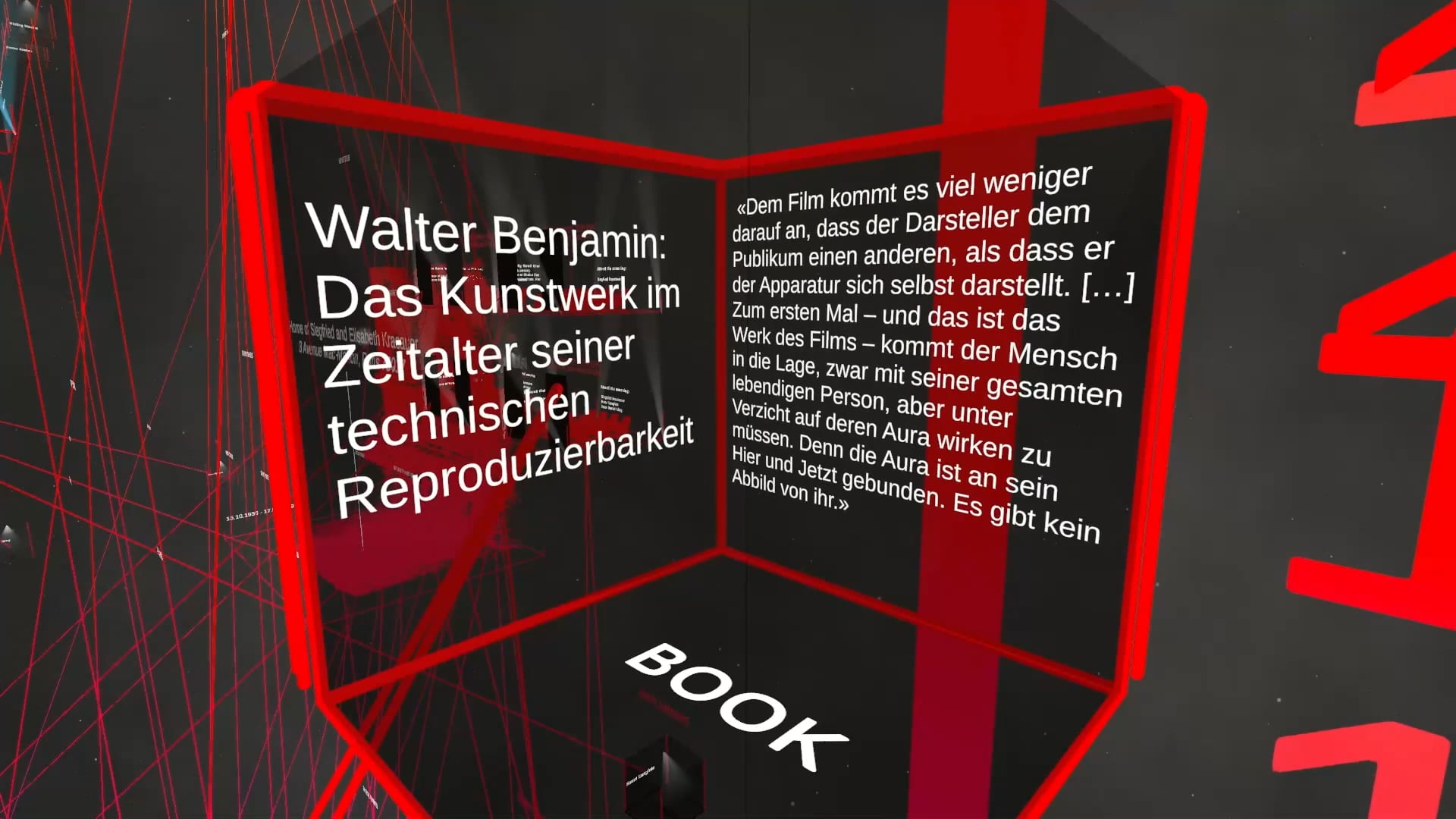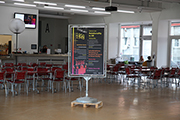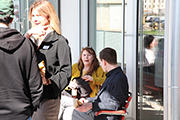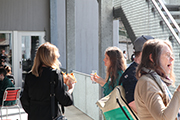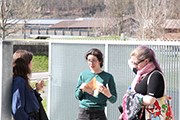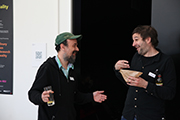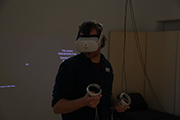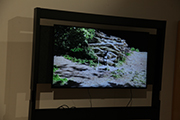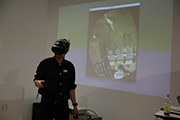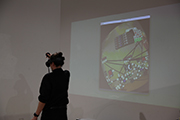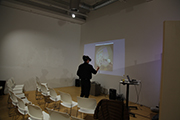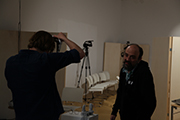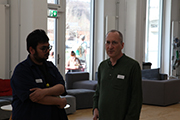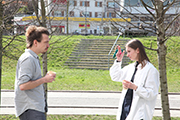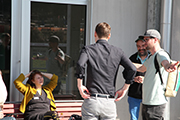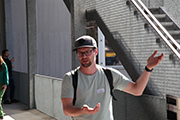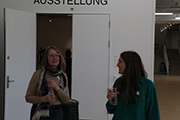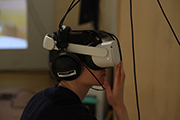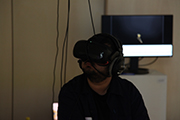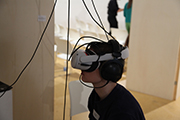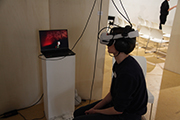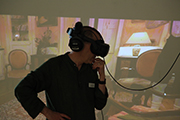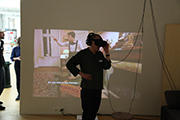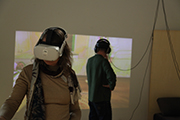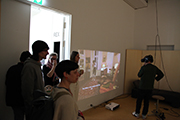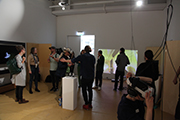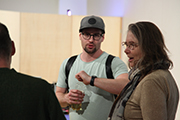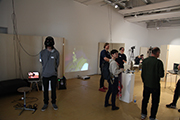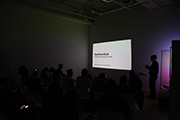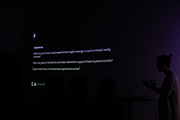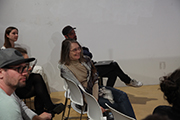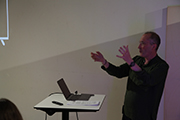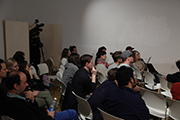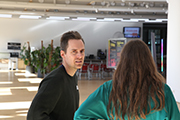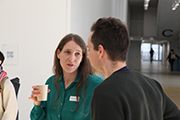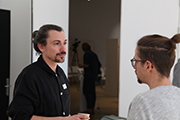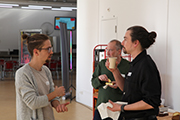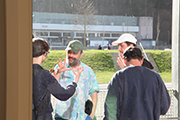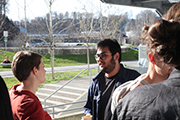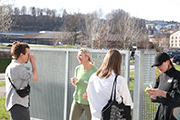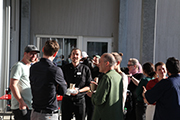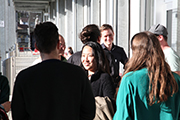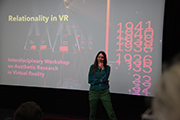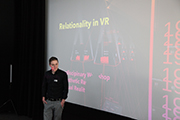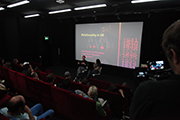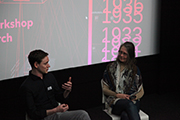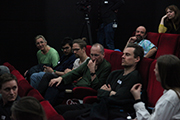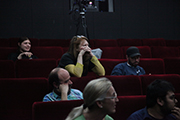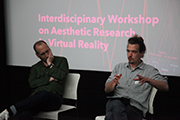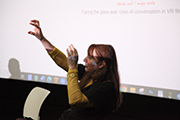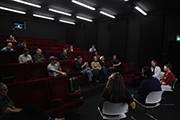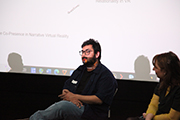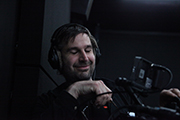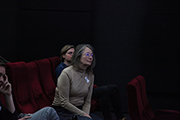Digital editions facilitate rich contextualisations of archival materials. In our research project we develop a new presentation and collaboration format for historic discourses including data visualisations in virtual reality.
Project Partners: German Literature Archive Marbach, University of Michigan, Immersive Arts Space (Zurich University of the Arts)
Topics
- News
- Collaborations
- Storytelling
- Epistemologies
Collaborators
-
Chris Elwis Leisi
Chris Elvis Leisi (M.A.) is teaching at the ZHdK in Game Design and researches in the Immersive Arts Space in the field of co-location, co-presence, mixed reality. Since 2015 Chris Elvis has been working with various XR glasses and experimenting with new interaction possibilities. He also teaches at the University of Applied Sciences Ravensburg-Weingarten in Game Design and is co-founder of the company ArchLevel GmbH.
- Chris Salter
-
Christina Zimmermann
Christina Zimmermann is a writer-director and artist focused on experimental, poetic storytelling and interaction. She teaches “Critical Storytelling” and mentors MA Film students at HSLU. She also leads an SNF Ambizione research project on digital representation in archives and is creating a VR biography of Siegfried & Elisabeth Kracauer. Christina earned a practice-based PhD from Bauhaus-University Weimar with a thesis on ambiguity in contemporary film (2016). www.christinazimmermann.com
- Christoph Schneider
- Dr. Tabea Lurk
-
Hana Yoo
Hana Yoo is interested in investigating the collective anxiety and transcendental experiences, formulated from the natural-artificial process of reversing perspective. Working in film and multimedia installation, she engages with the allegory of nature and technological appropriation in the context of human-environment transformation and reconstructs them through storytelling. Her works have been shown internationally at museums and festivals including the Fotomuseum (Winterthur, CH), European Media Art Festival (EMAF, DE), and Busan International Video Art Festival (Busan, KR) among others. In 2022, she was awarded the Berlin Art Prize. https://yoohana.net/
- Jessica Zippel
- Jony Margelist
- Juan Garcia
- Julius Lange
- Jürgen Enge
-
Katharina Fuchs
Katharina Fuchs is a PhD student in film studies at Universite Vincennes-Saint-Denis (Paris 8). In her work she questions the role of sound in the narrative structure of VR films, and how it might be used to overcome a lack of both interactivity and linearity in this genre. She has also been teaching information and communication studies at Universite Savoie-Mont-Blanc, and has collaborated with the interdisciplinary French-German journal Trajectoires and the cinema journal Théorème.
- Kevin Graber
- Kyra Palberg
- Lara Kothe
-
Ludwig Zeller
Ludwig Zeller, PhD has been a lecturer at the Institute Digital Communication Environments IDCE, Academy of Art and Design FHNW since 2011. Ludwig led the SNSF Spark project “Sonic Imagination,” which expanded on his research on meta-speculative atmospheres. The project aimed to create speculative scenarios by utilizing binaural headphone renditions of Ambisonics soundbeds in public space.
-
Manischa Eichwalder
Manischa Eichwalder (M.A.) is interested in critical practices in contemporary art. With a focus on virtual art she is currently a research assistant at the CRC 1567 “Virtual Lifeworlds”, Ruhr University Bochum. Before completing her Master’s degree in modern art history, she worked as a curatorial assistant at the Museum Folkwang, as head of art education at Urbane Künste Ruhr and studied Philosophy and Cultural Reflection.
-
Manuel van der Veen
Dr. des. Manuel van der Veen completed his doctorate in 2022 on the topic of “Augmented Reality. Trompe-l’oeil and Relief as Technique and Theory” after studying Fine Arts at the AdBK Karlsruhe and Philosophy at the Albert-Ludwigs-Universität Freiburg from 2012-2017. Since 2022, he has been a research assistant in the art historical sub-project C03 “Virtual Art” of the CRC 1567 “Virtual Lifeworlds” at Ruhr University Bochum. His research interests also include the philosophy of space and technology as well as the theory and history of painting.
-
Marie-Laure Cazin
Dr. Marie-Laure Cazin is an artist, filmmaker and a researcher, affiliated to the Enactive Virtuality Laboratory, Tallinn University, Estonia. She is a teacher at the Ecole Supérieure d’Art et de design ESAD-TALM in Tours-Angers-Le Mans (France), and at L’Ecole des Arts, Paris 1 University Panthéon-Sorbonne. She is developing art-science projects, creating cinematic and VR prototypes, using physiosensors for an implicit and emotional interaction between the film and the viewers. Her research is about the inner activity of the spectator.
- Matteo Bonera
-
Oliver Sahli
Oliver Sahli (M.A.) is a researcher at the Immersive Arts Space at the Zurich University of the Arts. His research focuses on the boundaries of XR technologies. He works as an Immersive Artist and is a consultant to the Canton of Aargau for XR in culture. He co-founded a Game Design Studio.
-
Paul Labelle
Paul Labelle is a doctoral researcher in media studies at the Research Training Group DFG-2291 “Gegenwart/Literatur” at the University of Bonn. He studied music at the Royal Northern College of Music, Manchester and musicology at the University of Hamburg. He is currently writing a dissertation on presence techniques in music, film, and video games. His research interests include: media and perception, sound, semiotics, and media theory.
- Pia Tikka
- Silvan Monteiro
-
Simon de Diesbach
Simon de Diesbach is an artist and research associate at Lucerne University of Applied Sciences and Arts. Simon completed the MA Film at HSLU and co-founded the production company Vise Haut Studio. His experimental animation film “Limits” (2022) uses 3D laser scanning and motion capture technologies, and is currently being screened at Film Festivals worldwide: Locarno (CH), Ars Electronica (AT), Anima (BE), Tampere (FI), Ann Arbor (US). Theoretical and practical research on new technological and aesthetic approaches are major interests of him. Simon de Diesbach regularly gives workshops in animation and design in various art Swiss schools and universities. https://simondediesba.ch/
- Susanne Guggenberger
- Sönke Kirchhof
- Thomas Baumgärtner
- Timo Heikkilä
- Yume Tanaka
Publications
Hidden Utopias 1960/today – Reconstructing a private meeting of Siegfried Kracauer and Theodor W. Adorno?
(text for preparation) #Workshop August 19-22, 2025 | Bergün, Switzerland / online

The future is made up of fragments of the past, and these fragments are the working tools to invent the future – Erwin Panofsky
The interdisciplinary workshop “Hidden Utopias in 1960/today” is the closing workshop of the SNSF design research project “Netted Letters in Immersive Environments” (2020-2025). It departs from a single archival document: a meeting protocol that Siegfried Kracauer wrote and revised after a pre-arranged encounter with Theodor and Gretel Adorno during their summer holidays 1960 in the Swiss Alps. In this text document, their respective philosophical standpoints regarding long-term intellectual controversies are hinted at from Kracauer's perspective. Our hermeneutic balancing act will depart from three little sketches in the lower margin of Kracauer's typescript and reflect epistemological and aesthetic implications of digital archival representations, research processes and historiography on the basis of a prototype for a research platform providing access to archival metadata and encouraging scientific collaboration.
(In-)visibility in 21st century archives
(conference website) #Panel @ Schweizerische Geschichtstage 2025 | 8.-11. Juli 2025, University of Lucerne
How can we deal with the narrativity of the visual when designing digital archives? Based on ongoing and completed research projects, this session will address the challenges and potentials of digital presentation and interaction with different types of historical sources. The future retrievability of these materials will be negotiated. The binary of visibility and invisibility will be differentiated into various degrees of transparency, as digital archives tend to prolong historical social biases, produce nonsensical conclusions based on incomplete or unbalanced metadata or - in their visualisations - suggest highly simplistic interpretations. The round of short presentations begins with a fictitious, interactive virtual reality archive. The subsequent panorama of speculative, gamified, collaborative, etc. approaches raises questions about the epistemic effects that the transition to visual paradigms in the field of historical studies entails and which we want to discuss in detail.
The True Film
(project website) #VR Experience - In Production
Siegfried Kracauer suffered from a speech impediment, but as a newspaper critic he was feared for his sharp tongue before he and his wife Elisabeth fled from the National Socialists and emigrated to the USA.
A historian is now digitising his estate Friedel and Lili, the avatars and restless souls of Siegfried and Elisabeth, appear in the archive and try to influence the historian in her work.
Inconsistencies emerge in the circle of friends, which includes renowned philosophers such as Walter Benjamin, Theodor W. Adorno and Ernst Bloch. In the interactive exploration of THE TRUE FILM, we stumble across gaps in the legacy and the suppressed role of women in male self-representation. A co-production of Mira Film and INVR.SPACE.
Kollektive Biographik in VR - Gedanken zu Turmbau und Vernetzung
(Programm_Tag der Landesgeschichte) #Presentation @ Digital History & Citizen Science: Digitale Methoden und neue Erkenntnisse zwischen digitaler Quellenerschließung, Forschung und Bürgerwissenschaften | 19.-22. September 2024 | Martin-Luther-Universität Halle-Wittenberg, Halle (Saale)
Im Designforschungsprojekt "Netted Letters in Immersive Environments" (SNF 2020-2025) entwicklen wir einen Prototyp für eine Forschungsplattform zur Recherche von Briefnachlässen und damit einhergehend eine neue Form der Intellektuellenbiografie. Die zentrale Frage, die wir diskursiv und gestalterisch zu beantworten versuchen: Wie lassen sich Fragmente aus Werken, Briefen und anderen Archivalien, sowie ihre Metadaten so zu räumlichen Erlebnissen verknüpfen, daß im Recherchieren mit der Zeit eine Vorstellung der biographierten Persönlichkeit Gestalt annimmt? Und was gilt es zu beachten, wenn diese Biographie von vielen zusammengetragen und weitergeschrieben wird?
Relationality in VR – Interdisciplinary Workshop on Aesthetic Research in Virtual Reality
(website) #March 22, 2023 | Lucerne University of Applied Sciences and Arts
How can we describe co-presence in Virtual Reality? Which modes of relationship are presupposed or encouraged by VR technology? Does a symptomatic reading of VR content and user behavior help us understand recent cultural, social and aesthetic dynamics? This interdisciplinary workshop pushes the boundaries of plausibility to explore the possible impact of corporeal experiences in digital encounters on our perceptual, social, and psychological capabilities.
Das unbestimmbare Murmeln in der Theorie des Films. Siegfried Kracauers filmontologische Auffassung vor und nach der Emigration
(Theoretischer Kontext) #Presentation @ German Studies Association Conference 2021, Indianapolis (hybrid)
Dass Siegfried Kracauers im amerikanischen Exil verfasste „Theorie des Films“ (1960) keine systematische filmontologische Position vermittelt, ist unter FilmwissenschaftlerInnen und KracauerexpertInnen weitgehend Konsens. Nachträgliche Klärungsversuche sind dennoch zahlreich, sei es beispielsweise durch Kontextualisierung im medientheoretischen Diskurs oder als Richtigstellung, anschreibend gewissermaßen gegen Theodor W. Adornos Diktum vom „wunderlichen Realisten“. Dieser Beitrag vollzieht eine spekulative Annäherung an die konzeptuellen Verschiebungen, die sich über Kracauers Texte verstreut in einer Vielzahl filmontologischer Hinweise finden; angelehnt an seine eigene Methode, eine „Konstruktion im Material“.
Siegfried Kracauer zwischen den Stühlen
(Blog des Forschungsverbunds Marbach Weimar Wolfenbüttel) #Randnotizen zu seinem sozialen Netzwerk in Amerika - Blogbeitrag
Ein biographischer Essay, eine Momentaufnahme von Siegfried Kracauer Ende der 1950er Jahre, geschrieben im Anschluss an die erste längere Recherchephase im Deutschen Literaturarchiv Marbach 2017.



